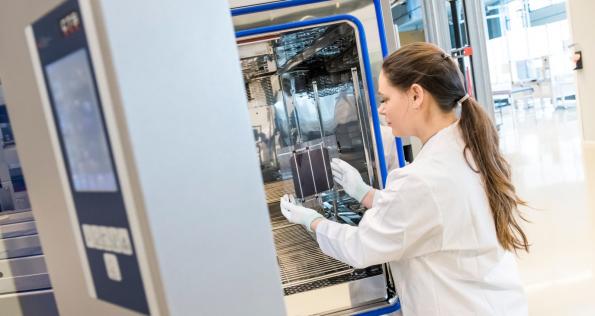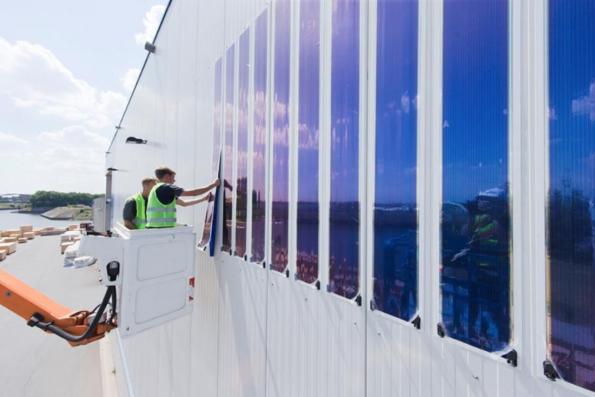The Sun’s the Limit - Further Proliferation of Solar Technology
13-05-2019 | By Mark Patrick
While Chinese companies currently dominate the production of solar cells using silicon substrates, European manufacturers have been pioneering two very different ways of capturing solar energy and converting it to electricity. Instead of needing to rely on the implementation of solar farms, covering many acres of land, it is now possible to utilise existing structures by cladding buildings in thin photovoltaic films.
The emergence of these two new classes of materials - organic dyes and perovskites - is leading to lightweight, thin film solar cells that can be mounted just about anywhere. The prospect of adding solar energy capturing capabilities to buildings quickly and easily, no longer needing broad areas of land or large and costly power inverters, could result in a dramatic increase in the amount of future renewable power that society can access and help cut global carbon emissions.
Unlike traditional cells, these ground-breaking thin films can also be tuned to be sensitive to different frequencies of light. They can accordingly serve as the upper layer in tandem solar cells - thereby delivering much higher degrees of conversion efficiency from solar panels without dramatically increasing the cost or weight of the overall assembly.
IMEC
The IMEC research lab in Belgium has developed a 4-terminal thin film tandem solar cell, featuring a perovskite top layer, with an efficiency of 24.6%. This top layer uses light in the visible part of the spectrum with a wide bandgap of 1.72eV, while the light in the near-infrared (NIR) spectrum that passes through the perovskite cell is harvested by the underlying copper indium gallium selenide (CIGS) cell. The solar cell assembly measures just 0.5cm² but, according to researchers, it could be scaled up for industrial production. It is also anticipated that further work on the perovskite material would enable the boosting of efficiency levels to over 30%.
Oxford Photovoltaic has been working on perovskite materials to address various applications for 20 years and is now starting commercial production of its solar-targeted technology at a plant in Dresden, Germany. As part of this venture, it is leading a €2.8m project to demonstrate high volume manufacturing of perovskite-silicon tandem solar cells with elevated efficiencies.

Figure 1: Oxford Photovoltaic Manufacturing Process.
Oxford Photovoltaic
Through collaboration with thin film equipment maker Von Ardenne, the Helmholtz-Zentrum Berlin Research Institute, the Fraunhofer Institute for Solar Energy Systems and the Technical University of Berlin, Oxford Photovoltaic is optimising the combined perovskite-silicon solar cell architecture for fabrication on industrial 156mm x 156mm wafers. The company has already achieved a world record certified efficiency of 27.3% for its tandem cell - exceeding the 26.7% efficiency world record for a single junction silicon cell.
Heliatek
Heliatek in Germany has used an organic dye material to produce thin-film solar cells that can be conveniently placed on rooftops or the sides of buildings. It has been working with the German river port at Duisburg to install 185sq.m of film on the side of a large building complex - with 192 panels, each 3m long. This represents one of the most significant installations of organic photovoltaic (OPV) hardware in the world to date. The technology can even be incorporated directly into glass or concrete of new builds so that the panels themselves are not necessary.
Concrete maker Lafarge may not at first seem like a natural partner for an electronics technology company, but it has engaged with Heliatek on the embedding of solar films and associated electronics into pre-cast concrete panels that can cover the outside of a building and generate substantial quantities of power. A 10-storey commercial building where 60% of its facade is covered with the solar film cladding system could take care of approximately a third of its annual energy requirements. The two companies have been working on ready-made panels with the collection electronics included so that they are easy for builders to install and connect into the building’s electricity supply.

Figure 2: Heliatek Instalation at Duisburg.
To make things simpler still, the films can go on or even in windows to generate power. Tuned to mainly capture infrared (IR) rather than visible light, these films have a transparency of around 30% - so there isn’t too much of a reduction in the light going into the building (and there thus won’t be a significant impact on its occupants). Consequently, power can be generated without needing to either deploy panels on the roof or blocking the view out of the windows.
With all these projects, Heliatek has started mass production of the film, moving from its pilot line with rolls that are 30cm wide to industrial scale 1.2m-wide rolls. This roll-to-roll (R2R) production technique is essential to drive down the cost to a few pennies per sq.m, and in turn, it is the cost reduction realised that will allow the films to be mounted on to many building to generate power.
Combining both perovskite and thin film R2R technologies, Solliance (a grouping of research centres and companies from the Netherlands, Belgium and Germany) is working with Solartek, Dyesol and Panasonic, on high-efficiency solar cells. The current world record efficiency of a small, lab scale perovskite-based thin film cell is 22.1%, while other R2R technologies using organic dyes have reached 13%.
The challenge is to scale up perovskite cells to larger size, industrially-manufacturable modules with elevated efficiency properties and long operational lifetimes while keeping unit costs low. The first step in the R2R development has shown an efficiency of 12.6% be attained, and this can be ramped up above 15% by while using low-cost materials and manufacturing procedures. The process was developed by Solliance, with its partners VDL Enabling Technologies Group, Smit Thermal Solutions and Bosch-Rexroth, and runs at 5m/min on a 30cm-wide commercial PET/ITO foil. While the efficiencies are less than those of the tandem perovskite-silicon panels, these films can be installed in many more places, enabling the generation of additional energy from sunlight and further reducing our dependence on fossil fuels.

